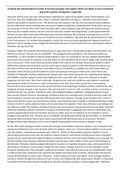Evaluate the interpretations in both of the two passages and explain which you think is more convincing
about the anarchy of Stephen’s reign [30]
Historians tend to have two main interpretations regarding the reign of King Stephen which lasted between 1135
and 1154. The more traditionalist view, which is evidently reflected in passage A, is that there was anarchy and
Stephen was unable to control his men. This period was dominated by civil war and central government ceased to
function with many barons exploiting the new system Stephen established, something which Poole seems to focus
on in passage A. On the other hand, other historians take a more revisionist view and argue that despite civil war,
there was not complete anarchy and was some law and order, despite this being limited. Central government did
function to some extent with writs still being issues and some historians like Carpenter in passage B focus on this,
arguing that this shows that there was not complete anarchy in Stephen’s reign and that he coped the best he could
in the circumstances. It is evident that passage B is clearly the most convincing regarding the supposed anarchy of
Stephen’s reign as passage A over exaggerates the limited instances of anarchy that did occur, ignoring the evidence
that there was law and order.
Passage A adopts the viewpoint that during Stephen’s reign, there was “unsurpassed savagery and bloodshed” and
that due to civil war “all work was at a standstill”. This passage focuses primarily on “the notorious Geoffrey de
Mandeville” as a key example of anarchy during Stephen’s reign. As a response to civil war, Stephen decentralised
government and created 20 earldoms in the East which he still controlled with 20 earls in charge with Geoffrey being
one of these earls. These earls acted as provincial leaders with control over all legal, financial and political matters
within their earldom and this system was very much open to abuse as justices of the eyre toured the country a lot
less often so these earls were held less accountable to the crown and thus corruption was more easily able to go
unnoticed. Some of these earls did exploit the system and passage A focuses on these earls, one of whom was
Geoffrey of Mandeville. Geoffrey defected and changed sides many times during the war, exploiting both Stephen
and Matilda’s need for support as both were fighting for the crown (the main cause of the civil war) so needed
supporters for their claim. Each time he defected, he gained more land and wealth because Stephen in particular
gave extensive lands to his barons in order to keep them on his side, hence why his earls had so much power
because this was to keep them on his side and prevent them from defecting to Matilda. Geoffrey exploited this, thus
leading to anarchy. Passage A also mentions “the earl of Chester’s revolt in 1146” as further evidence of anarchy as
Ranulf of Chester was another of Stephen’s earls who exploited Stephen’s weakness, besieging Leicester to gain
more land for himself. However, this passage is limited as these two examples were not typical and many earls and
barons helped to maintain law and order effectively within their earldoms. Passage A does mention that “scores of
lesser barns and free lances, up and down the country” were doing the same as Geoffrey and Ranulf but there is little
evidence for this in reality and the evidence we do have shows the opposite. There were still some court sittings and
tax collections within the earldoms, showing that there was not complete anarchy and some law and order remained
within the individual earldoms. Therefore, passage A is limited in that it exaggerates the extent to which there was
anarchy and generalises these two incidents because in reality, they are not reflective of all of Stephen’s barons.
Passage A also mentions how “all work was at a standstill” and whilst government was decentralised, as mentioned
previously there is evidence that to some extent, government did still function just at a local level. Therefore,
passage A holds many limitations and is a very simplistic interpretation of the anarchy in Stephen’s reign.
On the other hand, passage B, which is clearly the stronger interpretation of the two, adopts a more revisionist view,
arguing that whilst there was some disorder within the kingdom, there was “at least relative stability in some areas”
and that Stephen “maintained reasonable order within it”. Whilst not being entirely effective, Stephen’s plan to
decentralise government and create 20 earldoms instead worked to some extent. Keeping government centralised
during civil war would have been highly dangerous as Stephen did not control the whole kingdom so for example, his
itinerant justices may have been attacked and taxes may have been stolen whilst on their way to the exchequer in
Westminster. Therefore, Stephen adapted the best he was able to in wartime situations. Also, central government
did continue to function to some extent, though this was limited, showing how there was not complete anarchy.
Passage B mentions that “the exchequer continued to function” and whilst this may be an over simplification, there
is evidence that taxes continued to be collected and Stephen was never short of money, showing that the financial
system still functioned to some extent. Moreover, “justices went out to hear royal pleas” as the passage mentions
and this is evident through the evidence we have of some court sittings and writs being issued, though it is important
to mention that these were limited. Passage B also directly contradicts passage A, acknowledging that “individual




